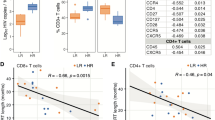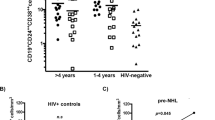Abstract
Adult T-cell leukemia/lymphoma (ATLL) develops after infection with human T-cell leukemia virus-1 (HTLV-1) after a long latency period. The negative regulatory programmed death-1/programmed death-1 ligand 1 (PD-1/PD-L1) pathway has been implicated in the induction of cytotoxic T-lymphocyte (CTL) exhaustion during chronic viral infection along with tumor escape from host immunity. To determine whether the PD-1/PD-L1 pathway could be involved in the establishment of persistent HTLV-1 infections and immune evasion of ATLL cells in patients, we examined PD-1/PD-L1 expression on cells from 27 asymptomatic HTLV-1 carriers (ACs) and 27 ATLL patients in comparison with cells from 18 healthy donors. PD-1 expression on HTLV-1-specific CTLs from ACs and ATLL patients was dramatically elevated. In addition, PD-1 expression was significantly higher on CD8+ T cells along with cytomegalovirus (CMV)- and Epstein–Barr virus (EBV)-specific CTLs in ATLL patients compared with ACs and control individuals. Primary ATLL cells in 21.7% of ATLL patients expressed PD-L1, whereas elevated expression was not observed in cells from ACs. Finally, in functional studies, we observed that an anti-PD-L1 antagonistic antibody upregulated HTLV-1-specific CD8+T-cell response. These observations suggest that the PD-1/PD-L1 pathway plays a role in fostering persistent HTLV-1 infections, which may further ATLL development and facilitate immune evasion by ATLL cells.
This is a preview of subscription content, access via your institution
Access options
Subscribe to this journal
Receive 12 print issues and online access
$259.00 per year
only $21.58 per issue
Buy this article
- Purchase on Springer Link
- Instant access to full article PDF
Prices may be subject to local taxes which are calculated during checkout




Similar content being viewed by others
References
Uchiyama T . Human T cell leukemia virus type I (HTLV-I) and human diseases. Annu Rev Immunol 1997; 15: 15–37.
Popovic M, Reitz Jr MS, Sarngadharan MG, Robert-Guroff M, Kalyanaraman VS, Nakao Y et al. The virus of Japanese adult T-cell leukaemia is a member of the human T-cell leukaemia virus group. Nature 1982; 300: 63–66.
Yoshida M . Multiple viral strategies of HTLV-1 for dysregulation of cell growth control. Annu Rev Immunol 2001; 19: 475–496.
Verdonck K, Gonzalez E, Van Dooren S, Vandamme AM, Vanham G, Gotuzzo E . Human T-lymphotropic virus 1: recent knowledge about an ancient infection. Lancet Infect Dis 2007; 7: 266–281.
Taylor GP, Matsuoka M . Natural history of adult T-cell leukemia/lymphoma and approaches to therapy. Oncogene 2005; 24: 6047–6057.
Tsukasaki K, Utsunomiya A, Fukuda H, Shibata T, Fukushima T, Takatsuka Y et al. VCAP-AMP-VECP compared with biweekly CHOP for adult T-cell leukemia-lymphoma: Japan Clinical Oncology Group Study JCOG9801. J Clin Oncol 2007; 25: 5458–5464.
Yamada Y, Tomonaga M, Fukuda H, Hanada S, Utsunomiya A, Tara M et al. A new G-CSF-supported combination chemotherapy, LSG15, for adult T-cell leukaemia-lymphoma: Japan Clinical Oncology Group Study 9303. Br J Haematol 2001; 113: 375–382.
Yasunaga J, Matsuoka M . Human T-cell leukemia virus type I induces adult T-cell leukemia: from clinical aspects to molecular mechanisms. Cancer Control 2007; 14: 133–140.
Proietti FA, Carneiro-Proietti AB, Catalan-Soares BC, Murphy EL . Global epidemiology of HTLV-I infection and associated diseases. Oncogene 2005; 24: 6058–6068.
Matsuoka M, Jeang KT . Human T-cell leukaemia virus type 1 (HTLV-1) infectivity and cellular transformation. Nat Rev Cancer 2007; 7: 270–280.
Arnulf B, Thorel M, Poirot Y, Tamouza R, Boulanger E, Jaccard A et al. Loss of the ex vivo but not the reinducible CD8+ T-cell response to Tax in human T-cell leukemia virus type 1-infected patients with adult T-cell leukemia/lymphoma. Leukemia 2004; 18: 126–132.
Kannagi M, Harashima N, Kurihara K, Ohashi T, Utsunomiya A, Tanosaki R et al. Tumor immunity against adult T-cell leukemia. Cancer Sci 2005; 96: 249–255.
Kozako T, Arima N, Toji S, Masamoto I, Akimoto M, Hamada H et al. Reduced frequency, diversity, and function of human T cell leukemia virus type 1-specific CD8+ T cell in adult T cell leukemia patients. J Immunol 2006; 177: 5718–5726.
Blank C, Mackensen A . Contribution of the PD-L1/PD-1 pathway to T-cell exhaustion: an update on implications for chronic infections and tumor evasion. Cancer Immunol Immunother 2007; 56: 739–745.
Greenwald RJ, Freeman GJ, Sharpe AH . The B7 family revisited. Annu Rev Immunol 2005; 23: 515–548.
Sharpe AH, Wherry EJ, Ahmed R, Freeman GJ . The function of programmed cell death 1 and its ligands in regulating autoimmunity and infection. Nat Immunol 2007; 8: 239–245.
Okazaki T, Honjo T . Rejuvenating exhausted T cells during chronic viral infection. Cell 2006; 124: 459–461.
Nishimura H, Minato N, Nakano T, Honjo T . Immunological studies on PD-1 deficient mice: implication of PD-1 as a negative regulator for B cell responses. Int Immunol 1998; 10: 1563–1572.
Brown JA, Dorfman DM, Ma FR, Sullivan EL, Munoz O, Wood CR et al. Blockade of programmed death-1 ligands on dendritic cells enhances T cell activation and cytokine production. J Immunol 2003; 170: 1257–1266.
Freeman GJ, Long AJ, Iwai Y, Bourque K, Chernova T, Nishimura H et al. Engagement of the PD-1 immunoinhibitory receptor by a novel B7 family member leads to negative regulation of lymphocyte activation. J Exp Med 2000; 192: 1027–1034.
Blank C, Kuball J, Voelkl S, Wiendl H, Becker B, Walter B et al. Blockade of PD-L1 (B7-H1) augments human tumor-specific T cell responses in vitro. Int J Cancer 2006; 119: 317–327.
Dong H, Chen L . B7-H1 pathway and its role in the evasion of tumor immunity. J Mol Med 2003; 81: 281–287.
Iwai Y, Ishida M, Tanaka Y, Okazaki T, Honjo T, Minato N . Involvement of PD-L1 on tumor cells in the escape from host immune system and tumor immunotherapy by PD-L1 blockade. Proc Natl Acad Sci USA 2002; 99: 12293–12297.
Barber DL, Wherry EJ, Masopust D, Zhu B, Allison JP, Sharpe AH et al. Restoring function in exhausted CD8T cells during chronic viral infection. Nature 2006; 439: 682–687.
Day CL, Kaufmann DE, Kiepiela P, Brown JA, Moodley ES, Reddy S et al. PD-1 expression on HIV-specific T cells is associated with T-cell exhaustion and disease progression. Nature 2006; 443: 350–354.
Trabattoni D, Saresella M, Biasin M, Boasso A, Piacentini L, Ferrante P et al. B7-H1 is up-regulated in HIV infection and is a novel surrogate marker of disease progression. Blood 2003; 101: 2514–2520.
Trautmann L, Janbazian L, Chomont N, Said EA, Gimmig S, Bessette B et al. Upregulation of PD-1 expression on HIV-specific CD8+ T cells leads to reversible immune dysfunction. Nat Med 2006; 12: 1198–1202.
Osame M, Nakagawa M, Umehara F, Ijichi S, Moritoyo T, Higuchi I et al. Recent studies on the epidemiology, clinical features and pathogenic mechanisms of HTLV-I associated myelopathy (HAM/TSP) and other diseases associated to HTLV. J Neurovirol 1997; 3 (Suppl 1): S50–S51.
Shimoyama M . Diagnostic criteria and classification of clinical subtypes of adult T-cell leukaemia-lymphoma. A report from the Lymphoma Study Group (1984–1987). Br J Haematol 1991; 79: 428–437.
Kuzushima K, Hayashi N, Kimura H, Tsurumi T . Efficient identification of HLA-A*2402-restricted cytomegalovirus-specific CD8+ T-cell epitopes by a computer algorithm and an enzyme-linked immunospot assay. Blood 2001; 98: 1872–1881.
Betts MR, Price DA, Brenchley JM, Lore K, Guenaga FJ, Smed-Sorensen A et al. The functional profile of primary human antiviral CD8+ T cell effector activity is dictated by cognate peptide concentration. J Immunol 2004; 172: 6407–6417.
Altman JD, Moss PAH, Goulder PJR, Barouch DH, McHeyzer-Williams MG, Bell JI et al. Phenotypic analysis of antigen-specific T lymphocytes. Science 1996; 274: 94–96.
Bodinier M, Peyrat MA, Tournay C, Davodeau F, Romagne F, Bonneville M et al. Efficient detection and immunomagnetic sorting of specific T cells using multimers of MHC class I and peptide with reduced CD8 binding. Nat Med 2000; 6: 707–710.
Prussin C, Metcalfe DD . Detection of intracytoplasmic cytokine using flow cytometry and directly conjugated anti-cytokine antibodies. J Immunol Methods 1995; 188: 117–128.
Kanai T, Totsuka T, Uraushihara K, Makita S, Nakamura T, Koganei K et al. Blockade of B7-H1 suppresses the development of chronic intestinal inflammation. J Immunol 2003; 171: 4156–4163.
Saudemont A, Jouy N, Hetuin D, Quesnel B . NK cells that are activated by CXCL10 can kill dormant tumor cells that resist CTL-mediated lysis and can express B7-H1 that stimulates T cells. Blood 2005; 105: 2428–2435.
Rubio V, Stuge TB, Singh N, Betts MR, Weber JS, Roederer M et al. Ex vivo identification, isolation and analysis of tumor-cytolytic T cells. Nat Med 2003; 9: 1377–1382.
Arima N, Arimura K, Tokito Y, Sakaki Y, Matsushita K, Orihara K et al. HTLV-I Tax protein inhibits apoptosis induction but not G1 arrest by pyrrolidinedithiocarbamate, an anti-oxidant, in adult T cell leukemia cells. Exp Hematol 2004; 32: 195–201.
Hirata T, Uchima N, Kishimoto K, Zaha O, Kinjo N, Hokama A et al. Impairment of host immune response against strongyloides stercoralis by human T cell lymphotropic virus type 1 infection. Am J Trop Med Hyg 2006; 74: 246–249.
Steiner K, Waase I, Rau T, Dietrich M, Fleischer B, Broker BM . Enhanced expression of CTLA-4 (CD152) on CD4+ T cells in HIV infection. Clin Exp Immunol 1999; 115: 451–457.
Wintterle S, Schreiner B, Mitsdoerffer M, Schneider D, Chen L, Meyermann R et al. Expression of the B7-related molecule B7-H1 by glioma cells: a potential mechanism of immune paralysis. Cancer Res 2003; 63: 7462–7467.
Shimauchi T, Kabashima K, Nakashima D, Sugita K, Yamada Y, Hino R et al. Augmented expression of programmed death-1 in both neoplastic and non-neoplastic CD4+ T-cells in adult T-cell leukemia/lymphoma. Int J Cancer 2007; 121: 2585–2590.
Salih HR, Wintterle S, Krusch M, Kroner A, Huang YH, Chen L et al. The role of leukemia-derived B7-H1 (PD-L1) in tumor-T-cell interactions in humans. Exp Hematol 2006; 34: 888–894.
Nakanishi J, Wada Y, Matsumoto K, Azuma M, Kikuchi K, Ueda S . Overexpression of B7-H1 (PD-L1) significantly associates with tumor grade and postoperative prognosis in human urothelial cancers. Cancer Immunol Immunother 2007; 56: 1173–1182.
Maier H, Isogawa M, Freeman GJ, Chisari FV . PD-1:PD-L1 interactions contribute to the functional suppression of virus-specific CD8+ T lymphocytes in the liver. J Immunol 2007; 178: 2714–2720.
Acknowledgements
Research support: This study was supported by a Grant-in-Aid (to NA) from the Japanese Ministry of Health, Labor, and Welfare, and by the Kagoshima University for Frontier Science Research Center Program (to NA). We thank Dr Jeffrey A Medin for a critical reading of the paper, Ms Hokkoku for preparation of clinical samples, and Ms Ariyoshi for HLA typing.
Author information
Authors and Affiliations
Corresponding author
Additional information
This study was carried out at Kagoshima University.
Rights and permissions
About this article
Cite this article
Kozako, T., Yoshimitsu, M., Fujiwara, H. et al. PD-1/PD-L1 expression in human T-cell leukemia virus type 1 carriers and adult T-cell leukemia/lymphoma patients. Leukemia 23, 375–382 (2009). https://doi.org/10.1038/leu.2008.272
Received:
Revised:
Accepted:
Published:
Issue Date:
DOI: https://doi.org/10.1038/leu.2008.272
Keywords
This article is cited by
-
Impaired humoral immunity following COVID-19 vaccination in HTLV-1 carriers
BMC Infectious Diseases (2024)
-
CD30 stimulation induces multinucleation and chromosomal instability in HTLV-1-infected cell lines
International Journal of Hematology (2023)
-
Allogeneic hematopoietic stem cell transplantation for adult T-cell leukemia/lymphoma with HTLV-1-associated myelopathy
International Journal of Hematology (2021)
-
HLA-B*35 as a new marker for susceptibility to human T-cell lymphotropic virus type 1 (HTLV-1) Associated Myelopathy/Tropical Spastic Paraparesis (HAM/TSP) in patients living in Argentina
Retrovirology (2020)
-
Transplant-related complications are impediments to the success of allogeneic hematopoietic stem cell transplantation for adult T cell leukemia patients in non-complete remission
Bone Marrow Transplantation (2020)



